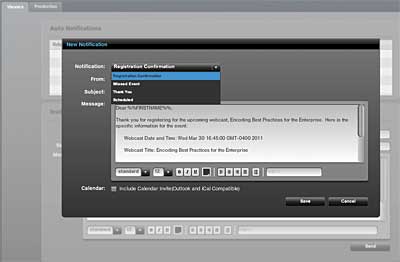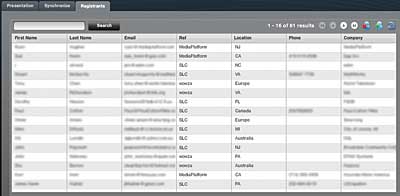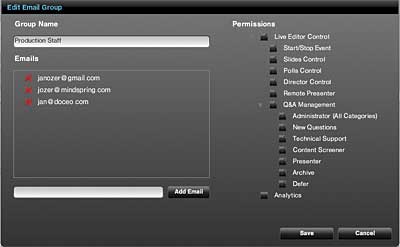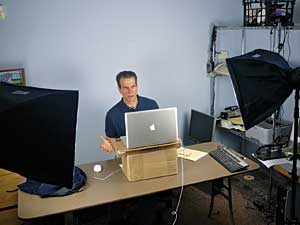MediaPlatform WebCaster Review: A Strong Option for Webcasts
In this regard, WebCaster contains four editable templates for Registration Confirmation (shown in Figure 5, which includes an Outlook and iCal compatible reminder; a reminder note (Scheduled) to send to registrants before the event; Missed Event, which sends the URL of the archived event to those who registered but didn’t actually attend; and a thank you note with the archived event URL for those who did attend. The Registration Confirmation is sent immediately upon registration, and you can schedule the others within the system.
 Rookie mistakes Nos. 2 and 3 were failing to include the Outlook/iCal reminder in the Registration Confirmation email and failing to send an automatic notification sometime before the webcast. In my experience with other webcasts, about half of the registrants actually attend, while my attendance was slightly below 33%. No doubt I could have improved this by using the tools that MediaPlatform provided.
Rookie mistakes Nos. 2 and 3 were failing to include the Outlook/iCal reminder in the Registration Confirmation email and failing to send an automatic notification sometime before the webcast. In my experience with other webcasts, about half of the registrants actually attend, while my attendance was slightly below 33%. No doubt I could have improved this by using the tools that MediaPlatform provided.
If you’re marketing your event through multiple sources, you can create a custom URL for each source so you can track their effectiveness. The directional URL is the same, but the reference can be different and will be reported as such by the program. For example, the URL that I used in the link from my website, www.streaminglearningcenter.com (SLC), ended with the phrase “ref+SLC.”
I was fortunate to have two other organizations help announce the webinar: MediaPlatform and Wowza Media Systems. Each had its own custom reference in its Lobby URL. You can see how this appears in the registration form in Figure 6. Obviously, this information is critical in determining which sources produced the best return.
Team Building
Though this wasn’t relevant to my presentation, WebCaster also includes the ability to create production groups and easily communicate with them via email. You create the group as shown in Figure 7, name the group, choose its functions and permissions, and add emails on the bottom. Once the group is saved, you can email all members simultaneously by selecting that group and creating your message.
 During the event, the assigned permissions will determine which functions the group can perform. For example, if you want to restrict access to the analytics for some groups, make sure the Analytics check box is empty for those groups.
During the event, the assigned permissions will determine which functions the group can perform. For example, if you want to restrict access to the analytics for some groups, make sure the Analytics check box is empty for those groups.
Staging the Event
Let’s spend a moment on the physical setup for the event. I decided to use my MacBook Pro to produce the webcast because its webcam and internal microphone work well for web conferences and because its 3.06 GHz Core 2 Duo CPU was more than sufficient for the 320x240 stream that I broadcast. I also wanted to keep things simple, so a separate camcorder and lavaliere system (which I definitely could have used) were out. Using a webcam, however, meant that I would have to be very close to the camera and microphone, so I would need lots of light.
As you can see in Figure 8, I have one light-blue wall in my office that I keep blank to use as a background for video shoots. I keep an inexpensive light kit (the ePhoto INC SFT2KIT, less than $200 at Amazon) with two 1,000 watt soft boxes assembled and ready to go for these occasions.
 The kit uses 5500K compact fluorescent bulbs that you can control individually if you’re trying for a shadowed, three-point lighting look. I was trying for flat lighting, so I powered on all the lights in both soft boxes and placed them equidistant at about 10 o’clock and 2 o’clock just slightly above my head and pointed down. Technically, I should also have a backlight shining down on my head and shoulders, but the contrast between my solid dark-blue shirt and solid light- blue background was sufficient without it.
The kit uses 5500K compact fluorescent bulbs that you can control individually if you’re trying for a shadowed, three-point lighting look. I was trying for flat lighting, so I powered on all the lights in both soft boxes and placed them equidistant at about 10 o’clock and 2 o’clock just slightly above my head and pointed down. Technically, I should also have a backlight shining down on my head and shoulders, but the contrast between my solid dark-blue shirt and solid light- blue background was sufficient without it.
Those solids were by design, of course, since pinstripes and other fine patterns quickly turn to mush under low-bandwidth, low-resolution compression. I also didn’t wear my black turtleneck because the contrast ratio, or the difference between the brightest brights and darkest darks in the frame, would have been too high for the webcam and compression technology to preserve. As it was, the blue shirt was a bit too dark and turned into a dark blob (but at least an artifact-free dark blob) during the webcast.
Not to go uber-geeky on you, but the difference between the detail that you see in my shirt in Figure 8 and the detail you don’t see in any of the webcast shots is what contrast ratio is all about. In Figure 8, the Panasonic digital SLR that I use has a much greater ability to preserve the extremes of contrast, as does the JPEG compression used by the camera. That’s why you see the collar and other details quite clearly, even though there was a great range between the brightest regions (such as the MacBook) and the dark shirt.
 In the webcast shots, the collar is gone because the inexpensive webcams and VP6 encoding just can’t preserve the same range of contrasts. You also see that the video is darker in the webcam, also the product of compression. The bottom line is that you should light like crazy and avoid extremes in brightness in your clothing and background.
In the webcast shots, the collar is gone because the inexpensive webcams and VP6 encoding just can’t preserve the same range of contrasts. You also see that the video is darker in the webcam, also the product of compression. The bottom line is that you should light like crazy and avoid extremes in brightness in your clothing and background.
Returning to the scintillating narrative, I also muted all the phones in my office and turned the heating way down so it wouldn’t start up loudly in the middle of the webcast. I couldn’t do anything about the dogs in the neighbor’s backyard, so I crossed my fingers and hoped for the best.
Related Articles
Companies no longer have to stream Windows Media inside the firewall and Flash outside, says enterprise pro.
21 Dec 2011
Two corporate video heavyweights integrate to offer customers a richer set of features.
13 Sep 2011
Also gains messaging and closed captioning, making the platform attractive to more users.
15 Jun 2011
MediaPlatform helped one of Canada's largest event companies take control of its webcasts.
10 Mar 2011
Solution saves enterprises the costs of installing and licensing Flash Media Server on premises.
02 Feb 2011
Companies and Suppliers Mentioned